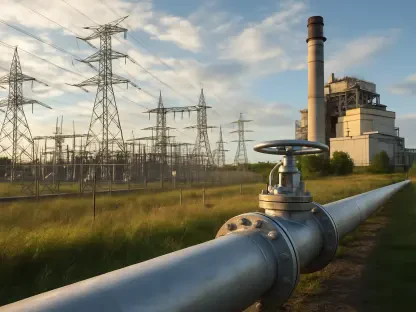The unveiling of DeepSeek’s low-cost AI model, DeepSeek-V3, has sparked a significant debate and market ramifications, particularly concerning the projected electrical demand necessary to support data centers in the U.S. This development has far-reaching implications for various segments of the energy sector.
DeepSeek’s Breakthrough and Market Impact
DeepSeek-V3’s Efficiency Milestone
DeepSeek, a Chinese company, announced that its AI model, DeepSeek-V3, achieved significant computational efficiency using less than $6 million worth of Nvidia H800 chip computing power. This extraordinary milestone has positioned DeepSeek’s AI Assistant as the top-rated free application on Apple’s app store in the U.S., surpassing notable competitors such as ChatGPT. The unprecedented efficiency demonstrated by DeepSeek-V3 suggests a potential paradigm shift in the AI landscape, indicating that substantial computational power can be achieved with reduced electrical consumption and cost. The implications of this breakthrough extend beyond the mere technical achievement, as they resonate deeply within the broader AI ecosystem, affecting key stakeholders, including chip manufacturers and energy providers.
The rise of DeepSeek’s AI Assistant to the pinnacle of Apple’s app store highlights user adoption and growing reliance on efficient AI tools for a plethora of applications. This development has implications for the competitive dynamics in the tech industry, particularly for companies that supply the computational firepower needed to run these advanced AI systems. As DeepSeek-V3 achieves its notable efficiency, it challenges the existing models of electrical power consumption, potentially restructuring how companies approach AI development and implementation.
Nvidia’s Market Value Loss
Following DeepSeek’s announcement, Nvidia experienced a substantial market value loss of $589 billion on January 28, sending shockwaves across the tech and financial markets. This sharp decline reflects investor concerns about the future demand for Nvidia’s high-performance chips, which have been integral to AI advancements. The efficiency demonstrated by DeepSeek suggests a possible reduction in demand for high-end, power-intensive chips, which were forecasted to drive a significant portion of the U.S. electrical demand in the coming decade. The AI industry’s projected share of electricity consumption, estimated to be around 75% of the overall U.S. electricity demand by 2030-2035, is now under intense scrutiny.
This sudden market value loss underscores the interconnectedness of technological advancements and market dynamics. Investors are acutely aware that any development which potentially reduces the power requirements for AI could lead to significant shifts in the demand for both hardware and energy. The efficiency gains presented by DeepSeek-V3 introduce a layer of uncertainty into future electricity demand projections, necessitating a comprehensive reevaluation by stakeholders. This has prompted analysts to consider the broader implications for the energy sector and independent power producers, who have been preparing for a rapid increase in demand from data centers and AI applications.
Implications for the Energy Sector
Re-evaluation of Power Demand Projections
The groundbreaking efficiency of DeepSeek-V3 necessitates a reevaluation of how much power will be necessary to meet the evolving AI industry’s needs. Such a reassessment holds significant implications for independent power producers and integrated utilities that have heavily banked on the data center sector’s electrical demands. Given the previous projections that AI would constitute a substantial portion of future electricity consumption, this development forces a revision of strategic planning and investment decisions within the energy sector. It also implies potential recalibrations in infrastructure development and resource allocation to ensure alignment with the newly anticipated demand levels.
Revisiting power demand projections also means considering the sustainability and environmental implications of energy consumption in AI. If AI’s power requirements are indeed lower than previously thought, there could be a downward adjustment in emission projections and an increased feasibility for utilities to meet renewable energy targets. However, this possibility adds layers of complexity for energy planners who now must account for varying scenarios and their combinations, ensuring that they are prepared for different potential outcomes. The recalibration will involve integrating insights from AI efficiency advancements while balancing the need for reliable and scalable power sources.
Impact on U.S. Utilities and Energy Companies
The announcement from DeepSeek had immediate ripple effects on stock prices for U.S. utilities, energy companies active in the data center space, and advanced nuclear technology companies such as NuScale and Oklo. These entities have been strategizing around substantial increases in electrical demand driven by AI and data centers. The potential paradigm shift suggested by DeepSeek’s AI model efficiency introduced uncertainties that negatively affected market perceptions and stock valuations. Even so, Jefferies, an investment banking firm, predicted that DeepSeek’s launch represents an evolutionary step within the AI and software markets rather than a revolutionary one. This perspective aims to temper the initial reactions, suggesting the potential overreaction may normalize as the market adjusts to understanding the full implications of DeepSeek’s breakthrough.
Despite the market’s initial reaction, the longer-term view indicates that energy companies and utilities will need to adopt more nuanced strategies in response to changing power demand projections. This shift may involve greater flexibility in planning and a diversified approach to energy investments. Beyond immediate market movements, energy firms are likely to engage in continued analysis to refine their models and anticipate future trends. Figureheads within the industry may accrue deeper intelligence on potential scalability options for existing power sources and the integration of next-generation technologies to sustain AI and data center growth without compromising on efficiency or sustainability.
Strategic Investments in Power Solutions
Chevron and Engine No. 1’s Gas-Fired Power Plants
Chevron, the second-largest oil and gas company in the U.S., alongside investment firm Engine No. 1, announced plans to develop gas-fired power plants dedicated to supplying data centers. This initiative underscores Chevron’s natural gas capabilities in conjunction with GE Vernova’s turbine technology, presenting a tailored power solution to meet the specific needs of AI infrastructure. The project marks a strategic move to ensure that adequate and reliable power supply is available to sustain the growth and efficiency requirements of AI and data centers. These power plants aim to highlight the transferability of existing energy technology towards fulfilling the computational energy demands necessitated by AI, ensuring Chevron remains a crucial player in the evolving energy landscape.
Chevron’s CEO Mike Wirth emphasized that this partnership is envisioned to leverage natural gas as a reliable path to develop power solutions for AI advancements. Engine No. 1’s founder, Chris James, pointed out the strategic importance of utilizing domestic natural gas to facilitate AI’s growth and economic productivity, signaling alignment between energy solutions and technological progression. The joint effort by Chevron and Engine No. 1 demonstrates adaptive strategies to meet specific power needs while showcasing the ability to integrate existing energy resources, beneficially both economically and technologically.
Major Deals and Ongoing Plans
Reflecting the overarching interest from energy companies in securing and scaling up power supplies vital for data centers and AI, significant industry deals have transpired. Constellation’s acquisition of Calpine’s gas-fired power stations and NextEra Energy’s plans to develop additional gas-fueled plants with GE Vernova exemplify this trend. These moves underscore a concerted effort to enhance power infrastructure readiness to accommodate AI’s burgeoning energy needs. The incorporation of advanced gas turbine technology by industry leaders manifests a proactive approach to ensuring robust and responsive power systems capable of meeting evolving energy demands.
These strategic investments indicate an acute awareness of the potential changes driven by AI efficiencies. Company executives acknowledge the requirement for dependable energy sources and emphasize the importance of diversified portfolios to maneuver the shifting landscape. The development of gas-fueled plants serves as a cornerstone for these companies’ long-term planning, reflecting a blend of modern energy solutions geared to support significant computational loads while maintaining energy resilience and performance capabilities. This forward-looking approach emphasizes the utility sector’s adaptability and readiness to align with technological advancements shaping future energy consumption patterns.
Diverse Energy Strategies
Investments in Clean Energy Infrastructure
Thomas Byrne, CEO of CleanCapital, highlighted the substantial energy requirements that new investments in data centers will necessitate, advocating for simultaneous investments in clean energy infrastructure, such as solar power and energy storage. Byrne emphasized that as AI continues to grow and data centers expand, the integration of clean energy solutions is critical to ensuring sustainable development. He pointed out the current backlog in interconnection queues, which could impede the rapid deployment of these clean energy solutions if not adequately addressed. This situation underscores the need for administrative focus and policy support to clear obstacles and enable timely progress towards clean energy integration.
Byrne’s advocacy for clean energy solutions points to the broader need for an energy mix that balances reliability with sustainability. Investments in solar power and energy storage are seen as pivotal to meeting future energy demand while reducing carbon footprints. As the AI and data center sectors demand ever-greater amounts of power, aligning this growth with renewable energy infrastructure will be crucial in achieving broader environmental and policy objectives. This dual approach ensures that the advancements in AI do not come at the expense of ecological sustainability.
Role of Virtual Power Plants (VPPs)
Mathew Sachs of CPower highlighted the necessity of leveraging existing infrastructure to manage surging demand driven by computing and facility loads from AI and data centers. Virtual Power Plants (VPPs) present an immediate solution by optimizing current resources and addressing transmission and distribution constraints within the grid. VPPs aggregate multiple decentralized power sources, enabling more efficient use of available energy and offering flexibility in response to real-time demand fluctuations. This strategy capitalizes on existing infrastructure without requiring immediate, large-scale new developments, thereby facilitating a more seamless integration into the current energy landscape.
Sachs emphasized that deploying VPPs can alleviate pressure on the grid and improve overall resilience. By harnessing the collective capacity of distributed energy resources, VPPs create a virtual network that can respond dynamically to peak demands and ensure uninterrupted power supply. This approach not only maximizes efficiency but also helps mitigate the risks associated with over-reliance on singular large-scale power plants. The role of VPPs illustrates the innovative pathways available to utilities and energy companies in managing the evolving demands of AI and data centers, promoting a more sustainable and resilient energy ecosystem.
Industry Reaction and Long-Term Planning
Balancing Immediate Market Movements and Strategic Planning
The immediate market responses to DeepSeek’s announcement underscore a mixture of concern and cautious optimism for continued investment in power solutions tailored to AI’s growing demands. Industry stakeholders are navigating a carefully balanced outlook that incorporates elements of both immediate reactionary market movements and strategic long-term planning. As investors and companies adjust to the potential implications of DeepSeek’s AI efficiency, there is a recognition that long-term success will depend on adaptive strategies and robust planning. This includes reassessing investment priorities and exploring diversified energy solutions that can reliably meet future demand without compromising sustainability.
Jefferies’ perspective that DeepSeek’s launch represents an evolutionary step rather than a revolutionary disruption suggests that while the short-term impacts may appear significant, the long-term trajectory will likely involve gradually integrating efficiencies and innovations. As companies like Chevron, Constellation, and NextEra Energy proceed with their strategic investments, the broader industry will benefit from a blend of traditional and contemporary energy solutions. This balanced approach ensures that while responding to immediate market movements, the focus remains on building a resilient and adaptable infrastructure capable of supporting the sustained growth of AI.
Adaptable and Scalable Energy Solutions
The introduction of DeepSeek’s budget-friendly AI model, DeepSeek-V3, has stirred substantial debate and market consequences, especially regarding the forecasted electrical consumption required to sustain data centers in the United States. This new development carries extensive implications for different areas within the energy industry.
DeepSeek-V3, designed to be more affordable and efficient, could lead to increased adoption across various sectors, further driving the demand for powerful data center infrastructure. However, the anticipated rise in electrical consumption poses significant challenges. Industry experts are concerned about the strain this will place on the current power grid and the potential environmental impact.
This uptick in energy demand is prompting discussions on how to generate and manage this increased need for electricity sustainably. Solutions such as renewable energy sources, improved grid management, and energy-efficient technologies are being considered to address these challenges. Moreover, the need for robust policies and regulations to guide the sustainable growth of AI technology and its infrastructure is becoming increasingly apparent.
Therefore, while DeepSeek-V3 presents opportunities for technological advancement and economic growth, it also brings to light the pressing need for strategic planning and investment in the energy sector to support this advancement responsibly. This balance between innovation and sustainability will be crucial in shaping the future landscape of AI and energy consumption in the U.S.









